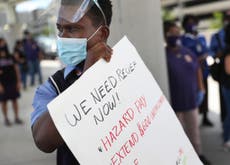Unofficial US unemployment rate may be over 25%, new data reveals
Workers who make less than living wage and those who have given up looking for work not included in data
Your support helps us to tell the story
From reproductive rights to climate change to Big Tech, The Independent is on the ground when the story is developing. Whether it's investigating the financials of Elon Musk's pro-Trump PAC or producing our latest documentary, 'The A Word', which shines a light on the American women fighting for reproductive rights, we know how important it is to parse out the facts from the messaging.
At such a critical moment in US history, we need reporters on the ground. Your donation allows us to keep sending journalists to speak to both sides of the story.
The Independent is trusted by Americans across the entire political spectrum. And unlike many other quality news outlets, we choose not to lock Americans out of our reporting and analysis with paywalls. We believe quality journalism should be available to everyone, paid for by those who can afford it.
Your support makes all the difference.New labour data suggests the "real" unemployment rate in the US may actually be 26.1 per cent.
Axios first reported on the staggering numbers.
The data defines anyone who is looking for full-time work that pays a living wage, but who cannot find it, as unemployed.
Current unemployment numbers tend to disregard individuals who make far less than a living wage and those who have stopped looking for work.
If the definition is expanded further to include anyone over the age of 16 who is not earning a living wage, the number inflates to 54.6 per cent. For black Americans, that number is even larger, 59.2 per cent.
Since the recession, only 46.1 per cent of white Americans over the age of 16 have a full-time job that pays more than $20,000 annually. Only 40.8 per cent of black Americans under that criteria have a full-time job making more than $20,000 annually.
The official unemployment rate in September was 8 per cent, down from 14.7 per cent at the height of the coronavirus pandemic in the US.
That number does not account for the nearly 700,000 people who have stopped looking for work after losing their jobs during the pandemic, nor does it account for the decrease of the labour force to 160.1m people in September. In August, the labour force was 164.5m people; that missing 4.4 million is not counted in the unemployment numbers.
According to data from the US Bureau of Labour Statistics, there were 24.2 million people who reported that they were unable to find work as a result of their employer closing or due to business losses due to the pandemic. Those people worked fewer hours or did not work at all at some point in the last month of the pandemic.
Only 11.6 per cent of those reporting they had lost business or work opportunities reported having received any sort of pay from their employer to compensate for the lack of work.
The number of people receiving unemployment benefits should reflect the unemployment rate. However, the current unemployment numbers suggest there are 13.6m people unemployed, even though 26m people are still receiving unemployment benefits.
That disparity suggests the real unemployment rate is much higher than the official numbers.



Join our commenting forum
Join thought-provoking conversations, follow other Independent readers and see their replies
Comments